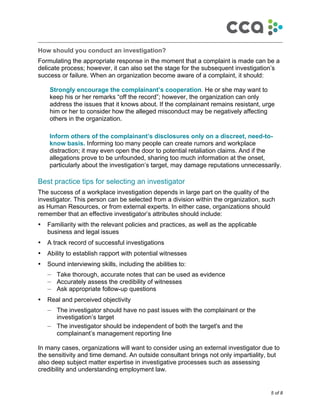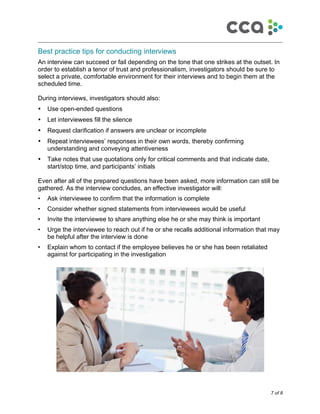Workplace Investigations
- 2. 2 of 8 ! Workplace Investigations “How organizations respond when allegations of inappropriate workplace behavior arise has the potential to impact legal risk as well as influence employee morale and public perception.” Xan Raskin, employment attorney and expert in workplace investigations What do you do when an employee makes a complaint? These are serious issues that require appropriate handling. Ms. Raskin, who has 18 years in employment law and extensive experience as a workplace conflict resolution expert, affirms that employers are responsible for conducting a thorough and prompt review of employee complaints; however, investigations that are managed internally face several challenges. Employees routinely perceive them as biased, and HR professionals can be placed in an awkward position, especially if senior-level or management personnel are involved. HR professionals also have a vested interest in protecting the important working relationships they have with client groups. Furthermore, they often don’t have the resources needed to conduct these time-sensitive investigations. Ms. Raskin encourages organizations to effectively resolve internal issues in a way that may prevent unnecessary escalation to litigation while protecting their employees, as well as the company’s reputation and goodwill. A professional investigation process is especially demanding since it includes: • Prompt, objective, and thorough reviews of complaints • Detailed review of relevant policies and procedures • Interviews of the individuals involved and key witnesses • A comprehensive investigation report • Steps to prevent retaliation
- 3. 3 of 8 ! Key considerations for an investigation When should you initiate a workplace investigation? Whenever an employee makes a complaint that that he or she has been the victim of discrimination, harassment, and/or retaliation, the organization has a responsibility to initiate an investigation. Employees can lodge such complaints in either a formal or an informal fashion. Formal complaints can be made as a written or verbal communication that specifically identifies an instance of discrimination, harassment, retaliation, or other workplace misconduct. HR may receive these formal complaints from an anonymous source, from the displeased employee, or from a supervisor or manager. The organization also may receive these complaints via external channels that can include: • Federal or state government agency (e.g, Equal Employment Opportunity Commission, New York State Division of Human Rights) • Attorney’s letter • Lawsuit Informal complaints can include: • Comments that reflect a general sense of unfair treatment at work, even when these comments do not identify specific examples • Comments made by employees to supervisors outside of work • Remarks overheard by a manager In order to determine if a formal investigation is in order, it may be necessary to obtain more information about the alleged behavior. Companies have an obligation to take all complaints seriously, including informal ones.
- 4. 4 of 8 ! Examples of complaints A few samples will help illustrate the various forms that employee complaints can take: “I just got back from maternity leave and my supervisor is really riding me. She’s much more critical and is micromanaging me more than ever before. And she is always giving me disapproving looks. It’s as if she is angry that I took all that time off.” “I’m much more qualified and seasoned than this kid right out of college who got the promotion over me. I wonder if they think I’m too old for the job?” “My boss interrupts me all the time in staff meetings. He never seems to have time for me. I was doing so well with my last boss, I even got a performance award. It must be because I’m female. I can’t think of what else it could be.” “I’ve gotten a few warnings for being late and am afraid I am going to get fired. I told my boss about the fact that my medication makes it hard for me to get up in the morning and be on time, and he just rolled his eyes at me.” “My IT guy makes me uncomfortable. He leans over me way too closely, and sometimes asks me questions that are just too personal.” “I’m not gay, but I overhear my co-workers joking around about gay people all the time. It’s distracting and getting to me.” What might trigger complaints? The volume of complaints can increase in response to a number of factors such as: • Mass layoffs, as well as their anticipation and aftermath • Approaching expiration of collective bargaining agreement(s) • Concerns about the organization’s profitability or success • Leadership changes • Mergers and acquisitions • Other examples of organizational change External factors also can influence the likelihood of employee complaints. These factors include: • Downturn in the economy • Changes in the labor/product market
- 5. 5 of 8 ! How should you conduct an investigation? Formulating the appropriate response in the moment that a complaint is made can be a delicate process; however, it can also set the stage for the subsequent investigation’s success or failure. When an organization become aware of a complaint, it should: Strongly encourage the complainant’s cooperation. He or she may want to keep his or her remarks “off the record”; however, the organization can only address the issues that it knows about. If the complainant remains resistant, urge him or her to consider how the alleged misconduct may be negatively affecting others in the organization. Inform others of the complainant’s disclosures only on a discreet, need-to- know basis. Informing too many people can create rumors and workplace distraction; it may even open the door to potential retaliation claims. And if the allegations prove to be unfounded, sharing too much information at the onset, particularly about the investigation’s target, may damage reputations unnecessarily. Best practice tips for selecting an investigator The success of a workplace investigation depends in large part on the quality of the investigator. This person can be selected from a division within the organization, such as Human Resources, or from external experts. In either case, organizations should remember that an effective investigator’s attributes should include: • Familiarity with the relevant policies and practices, as well as the applicable business and legal issues • A track record of successful investigations • Ability to establish rapport with potential witnesses • Sound interviewing skills, including the abilities to: — Take thorough, accurate notes that can be used as evidence — Accurately assess the credibility of witnesses — Ask appropriate follow-up questions • Real and perceived objectivity — The investigator should have no past issues with the complainant or the investigation’s target — The investigator should be independent of both the target's and the complainant’s management reporting line In many cases, organizations will want to consider using an external investigator due to the sensitivity and time demand. An outside consultant brings not only impartiality, but also deep subject matter expertise in investigative processes such as assessing credibility and understanding employment law.
- 6. 6 of 8 ! Best practice tips for preparing the investigation No matter who is given responsibility for the investigation, due diligence in the early stages of the process will be critical. Effective preparation for a workplace investigation requires one to: • Establish an investigation plan including — A timeline for the investigation — A list and order of potential witnesses (complainant, target, and eye-witnesses) • Review applicable documents such as: — Investigation protocols — Policies and standard operating procedures — Personnel file information — Performance documentation • Draft an interview question list • Draft a preamble to use with all interviewees in order to: — Explain the process — Discuss confidentiality — Explain prohibition against retaliation — Provide contact information — Express appreciation for participation An investigation may be about to commence, but work in the rest of the organization won’t come to a halt, and it may be necessary to make adjustments in the way that the complainant and the target get work done. Before making such determinations, Ms. Raskin suggests that the organization consider: “Is there any imminent risk that the alleged misconduct might reoccur?” “Do we expect the complainant and the alleged harasser to continue working together while awaiting the investigation’s conclusion?” “How concerned are we regarding potential retaliation and/or repetition of the alleged misconduct?” The answers to questions such as these will help decide what interim steps (if any) the organization should take. These interim steps can include: • Paid leave of absence (generally for the target of an investigation and not the complainant) • Temporary change in the reporting structure or in employee responsibilities • Reminders that retaliation is prohibited
- 7. 7 of 8 ! Best practice tips for conducting interviews An interview can succeed or fail depending on the tone that one strikes at the outset. In order to establish a tenor of trust and professionalism, investigators should be sure to select a private, comfortable environment for their interviews and to begin them at the scheduled time. During interviews, investigators should also: • Use open-ended questions • Let interviewees fill the silence • Request clarification if answers are unclear or incomplete • Repeat interviewees’ responses in their own words, thereby confirming understanding and conveying attentiveness • Take notes that use quotations only for critical comments and that indicate date, start/stop time, and participants’ initials Even after all of the prepared questions have been asked, more information can still be gathered. As the interview concludes, an effective investigator will: • Ask interviewee to confirm that the information is complete • Consider whether signed statements from interviewees would be useful • Invite the interviewee to share anything else he or she may think is important • Urge the interviewee to reach out if he or she recalls additional information that may be helpful after the interview is done • Explain whom to contact if the employee believes he or she has been retaliated against for participating in the investigation
- 8. 8 of 8 ! Conclusion Once all of the interviews have been conducted and the relevant information has been collected, investigators must reach a conclusion and, in most cases, prepare a written report. Investigators, as fact-gatherers, are responsible for determining whether an organization’s policies or standard operating procedures have been violated, and if so, by whom and to what degree. They do not reach legal conclusions. Decision-makers will then need to consider the facts gathered and determine an outcome, particularly if any remedial/disciplinary action is warranted, with the advice of counsel. The conclusion is usually communicated to parties that include the complainant. In order to obtain the full value from an investigation, an organization also will want to use its findings to ascertain if the alleged misconduct reflects isolated circumstances or if it is indicative of a broader issue, and if organizational factors helped encourage certain undesired behaviors. The organization then can use this information to customize compliance-training programs that can prevent similar cases from occurring in the future. About CCA & Artixan Consulting Group For 30 years, CCA has been supporting clients as an HR advisory firm. With roots in EAP, we support our clients through consulting, executive coaching, counseling, and crisis management. Artixan’s founder, Xan Raskin, Esq., SPHR, has spent her career as an employment attorney advising organizations on risk mitigation (including ten years as in-house legal counsel for Fortune 500 companies), conducting over 100 workplace investigations as a neutral party, serving as a mediator in employment disputes, and providing coaching and training on a variety of workplace conflict resolution issues. Our strategic partnership with Artixan Consulting Group gives our clients access to an employment expert and a top-notch resource for HR investigations. The combination of Artixan’s legal and compliance-based problem-solving with CCA’s psychological and behavioral insight enables us to provide a broad spectrum of HR services for our clients. To learn more about HR investigations or training your internal HR team, please contact us at 212.686.6827, or via email at mailto:cca@ccainc.com.








